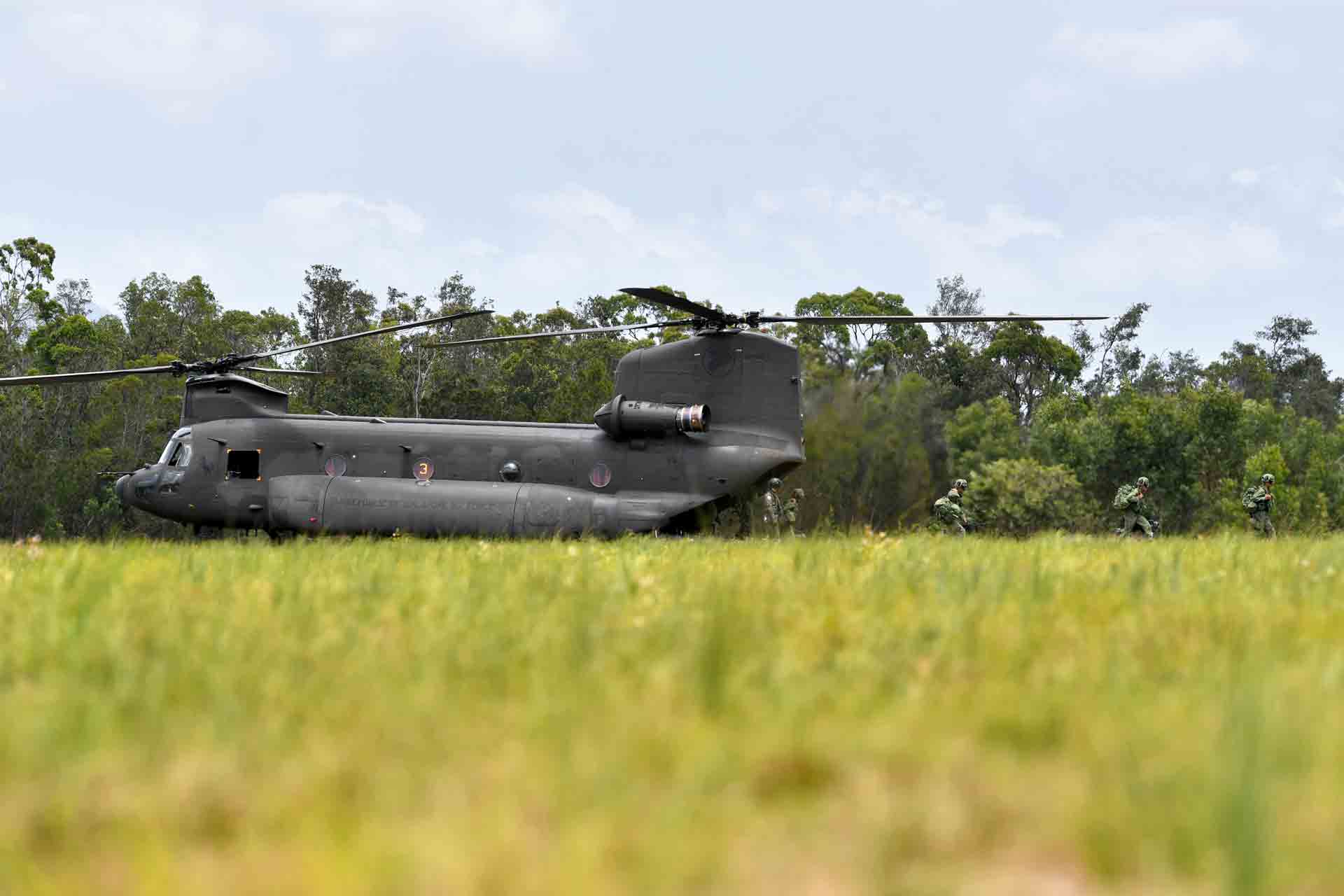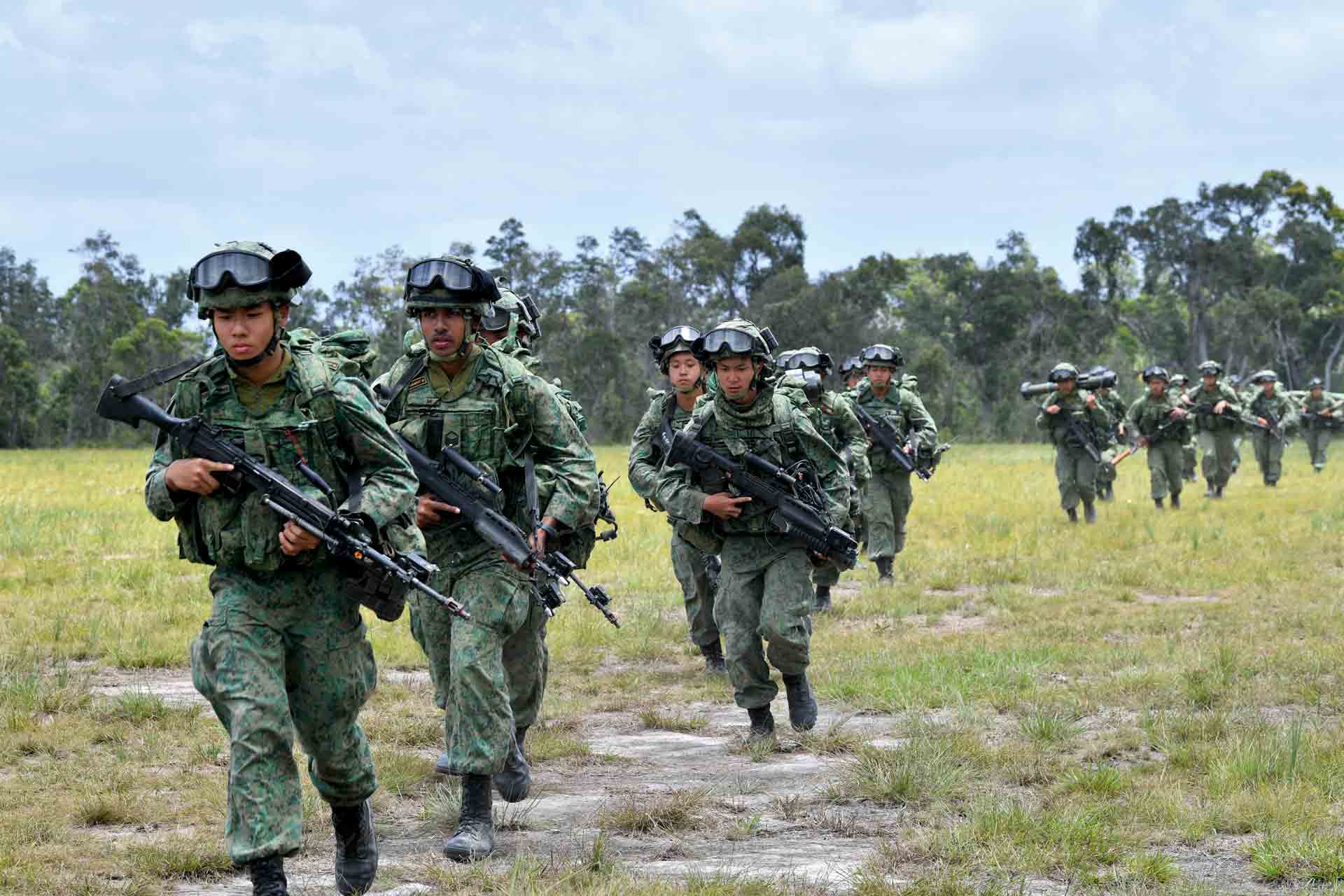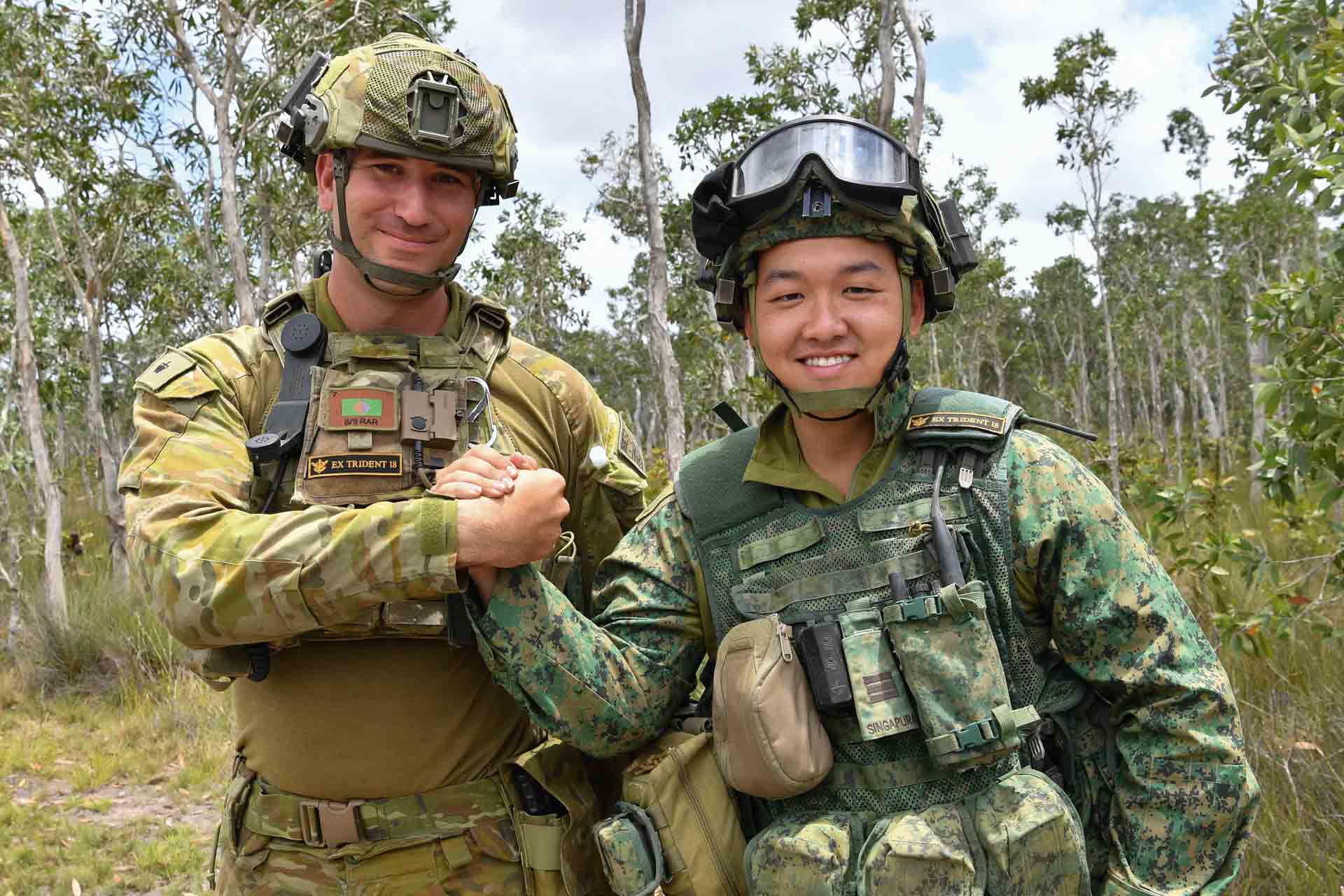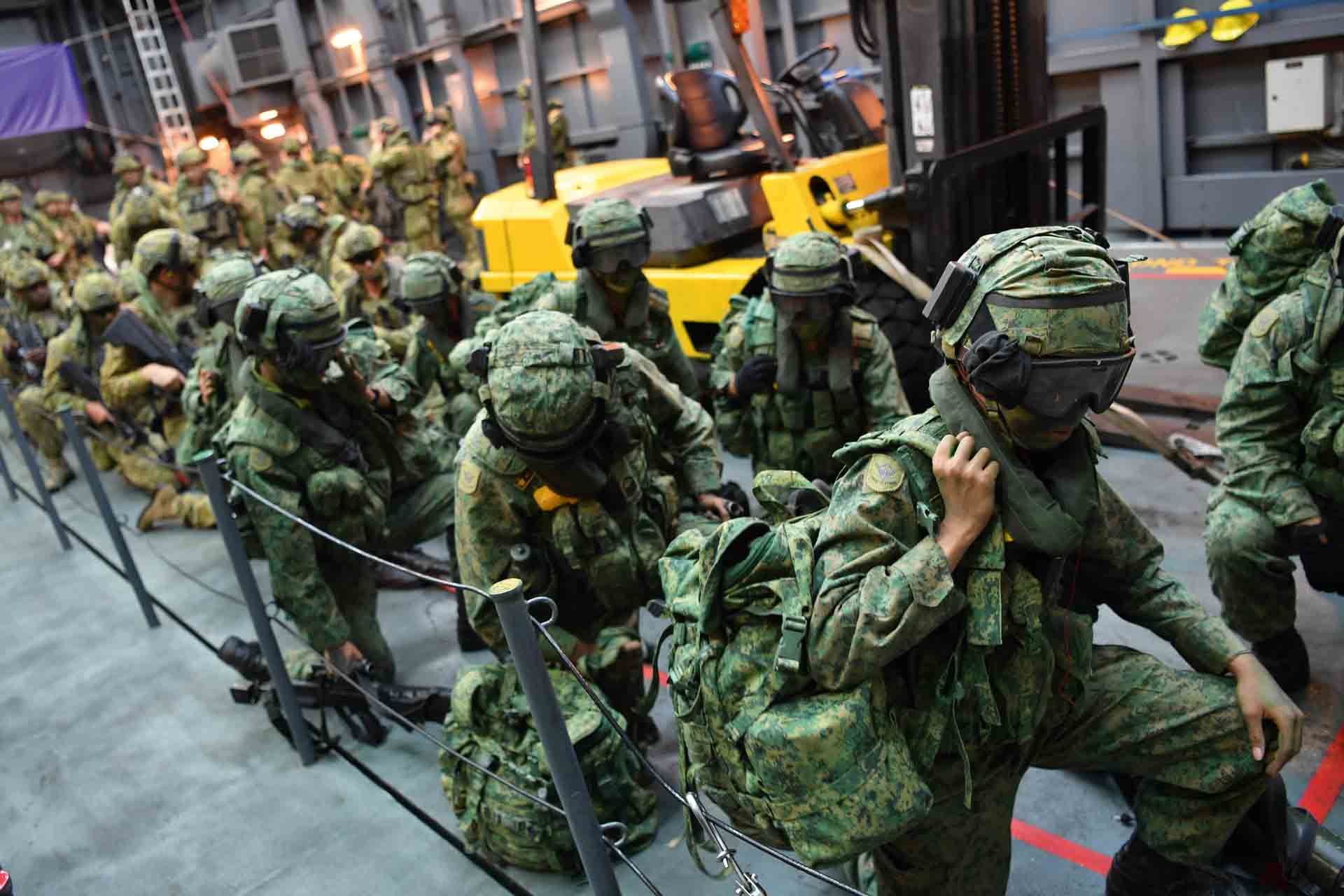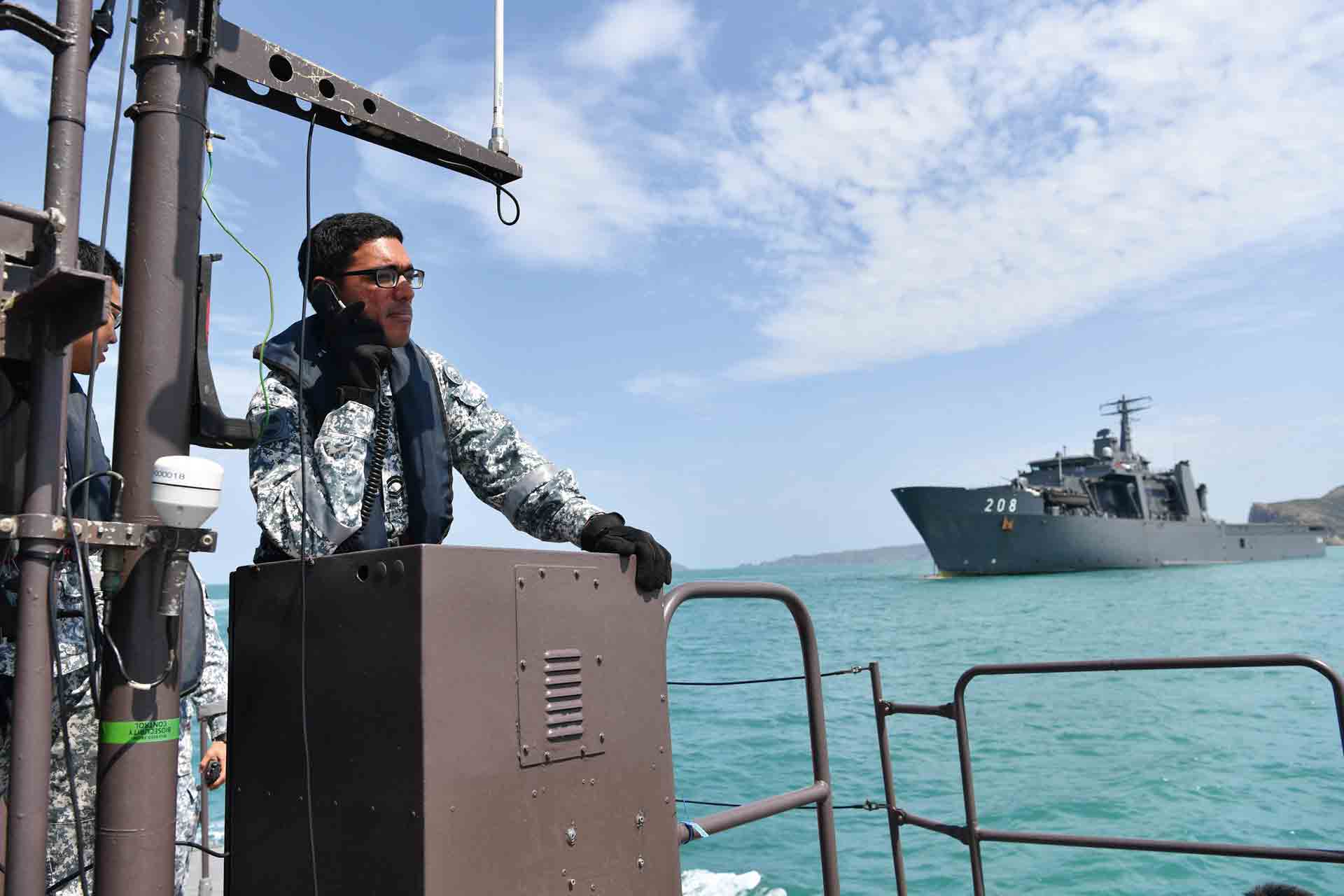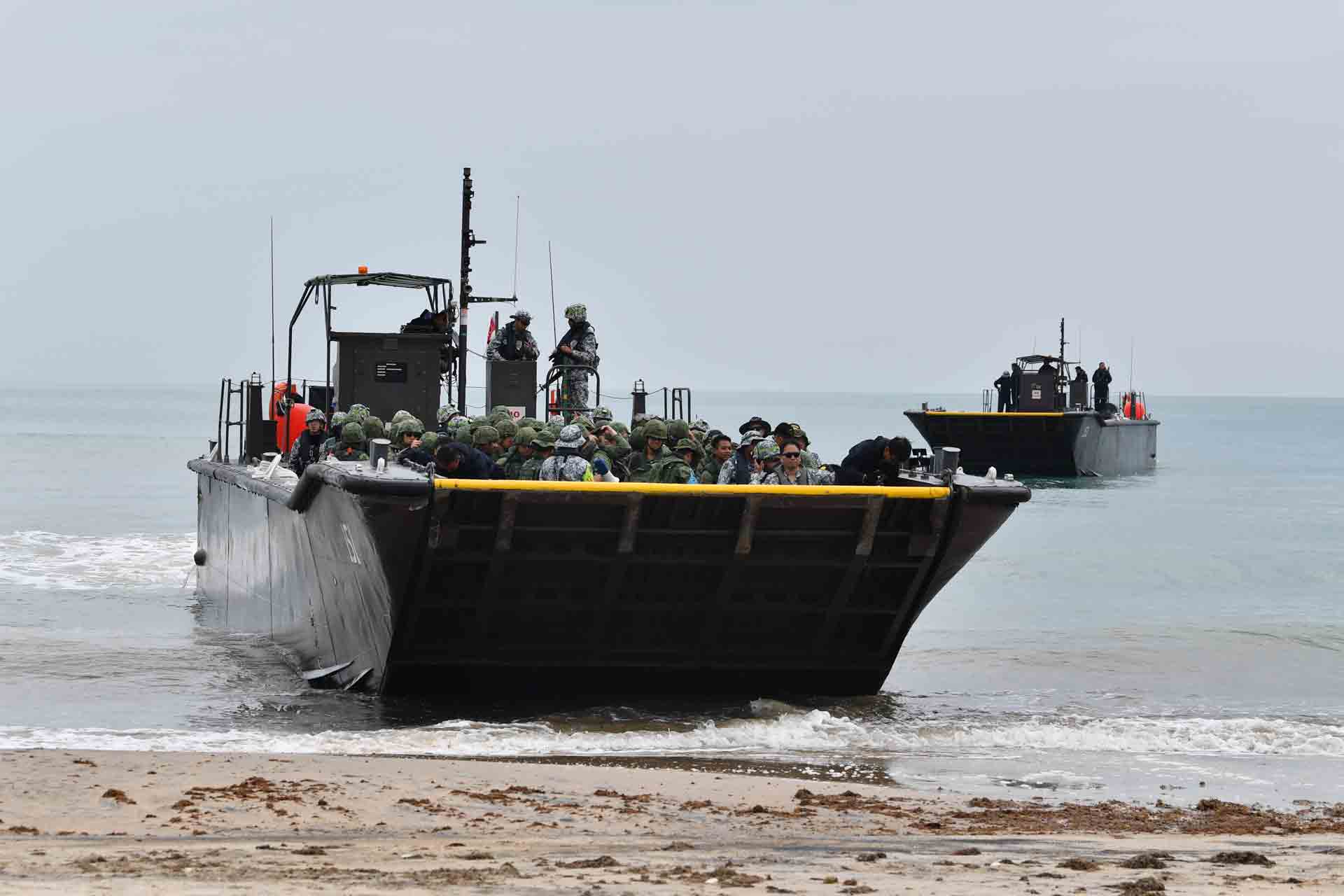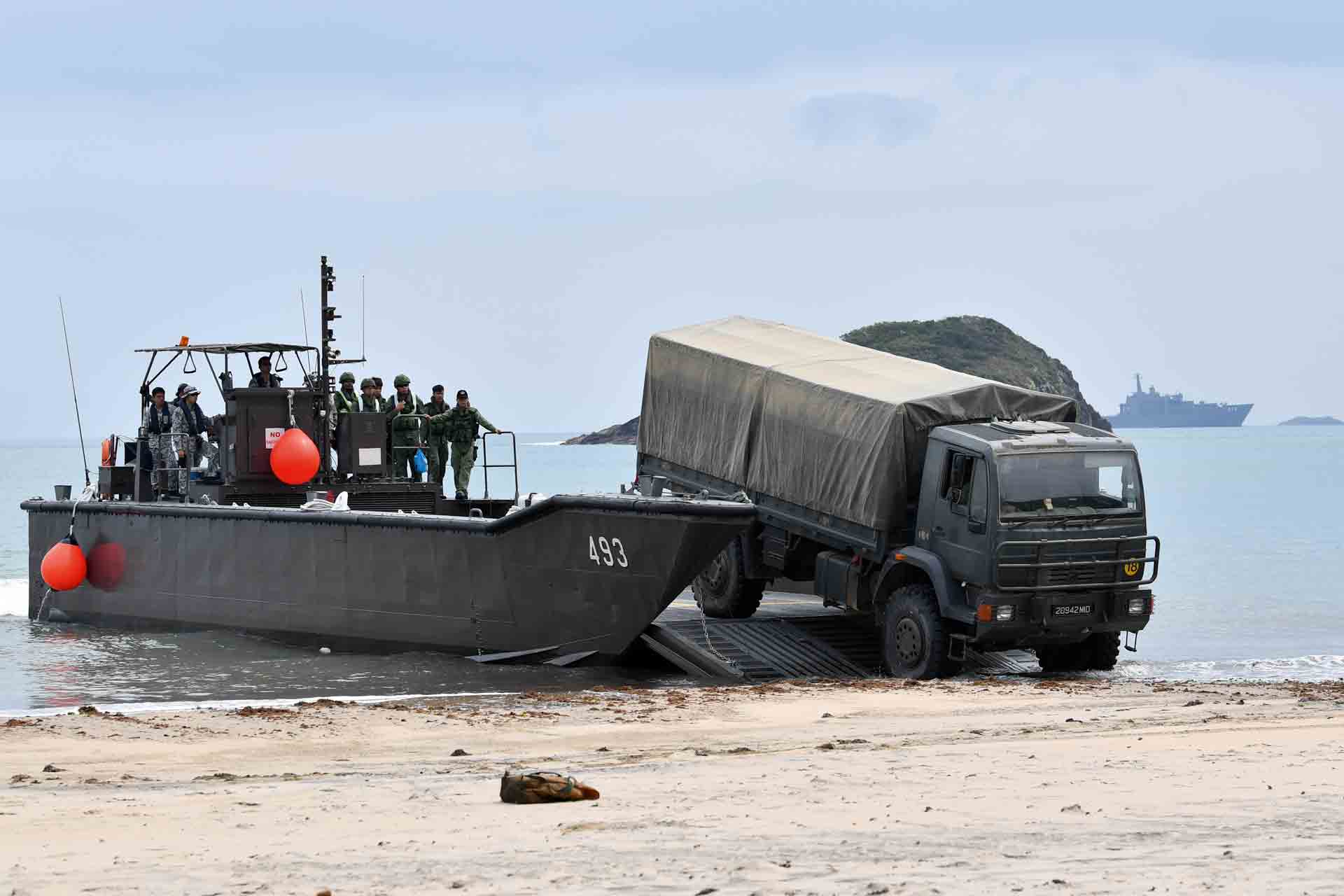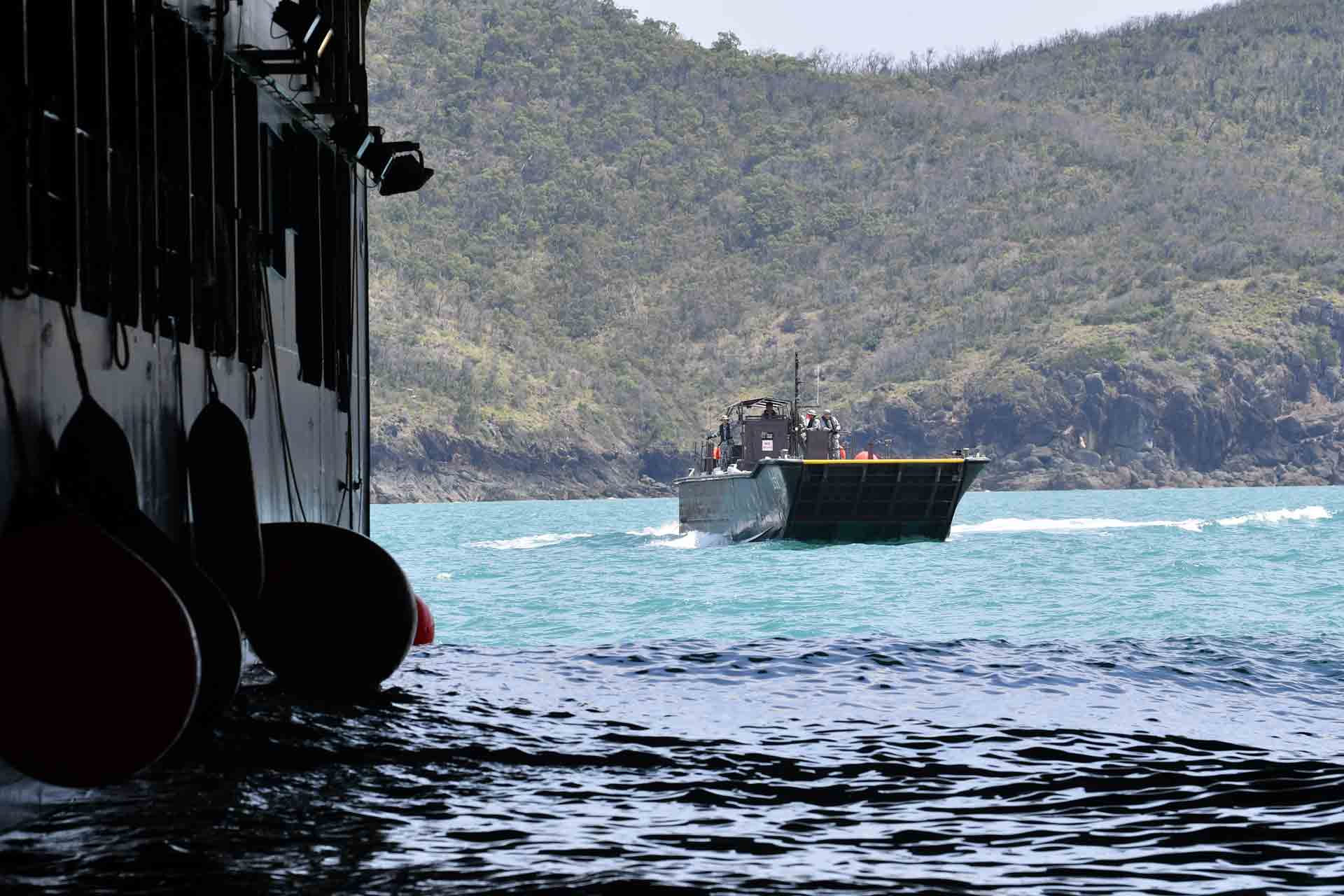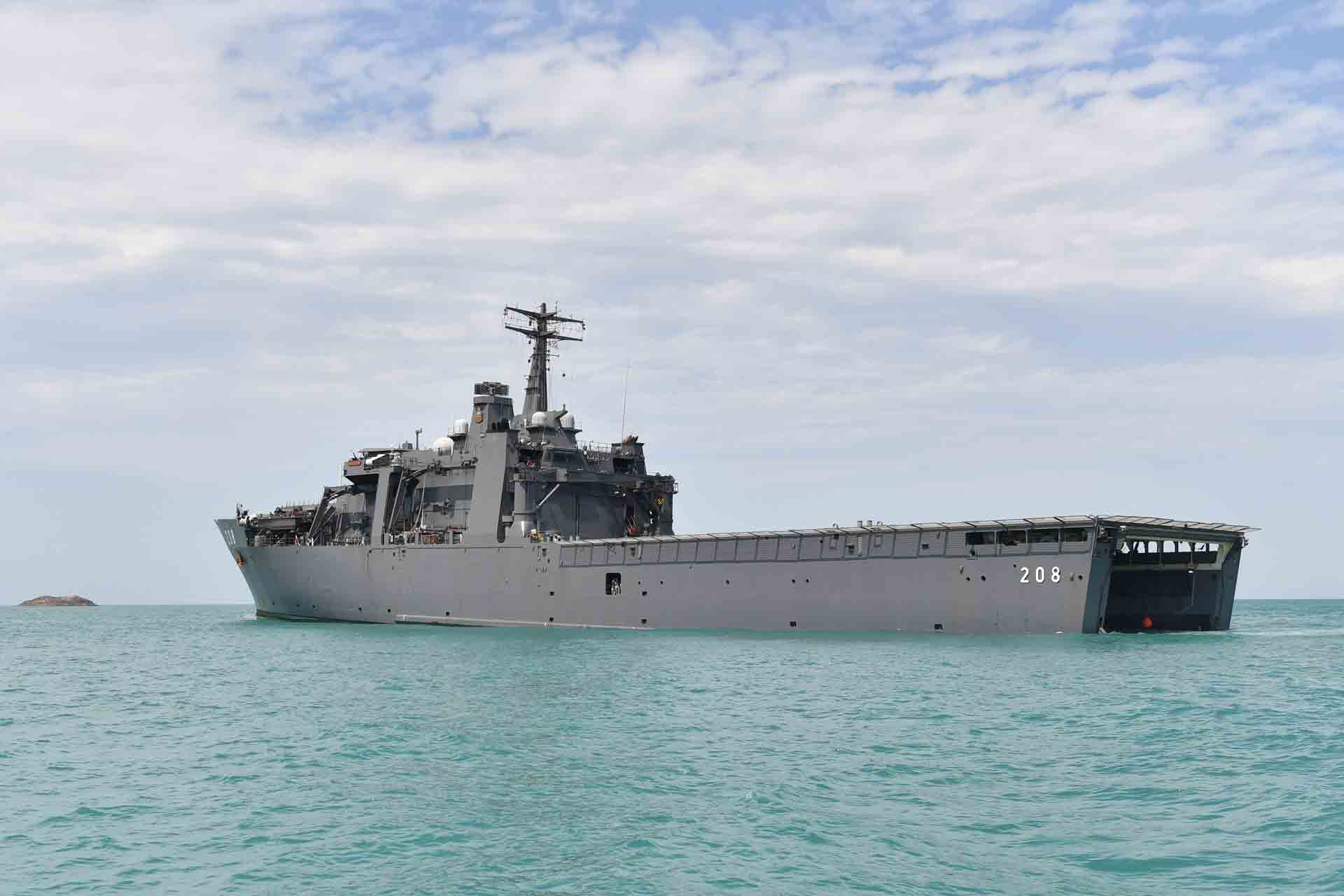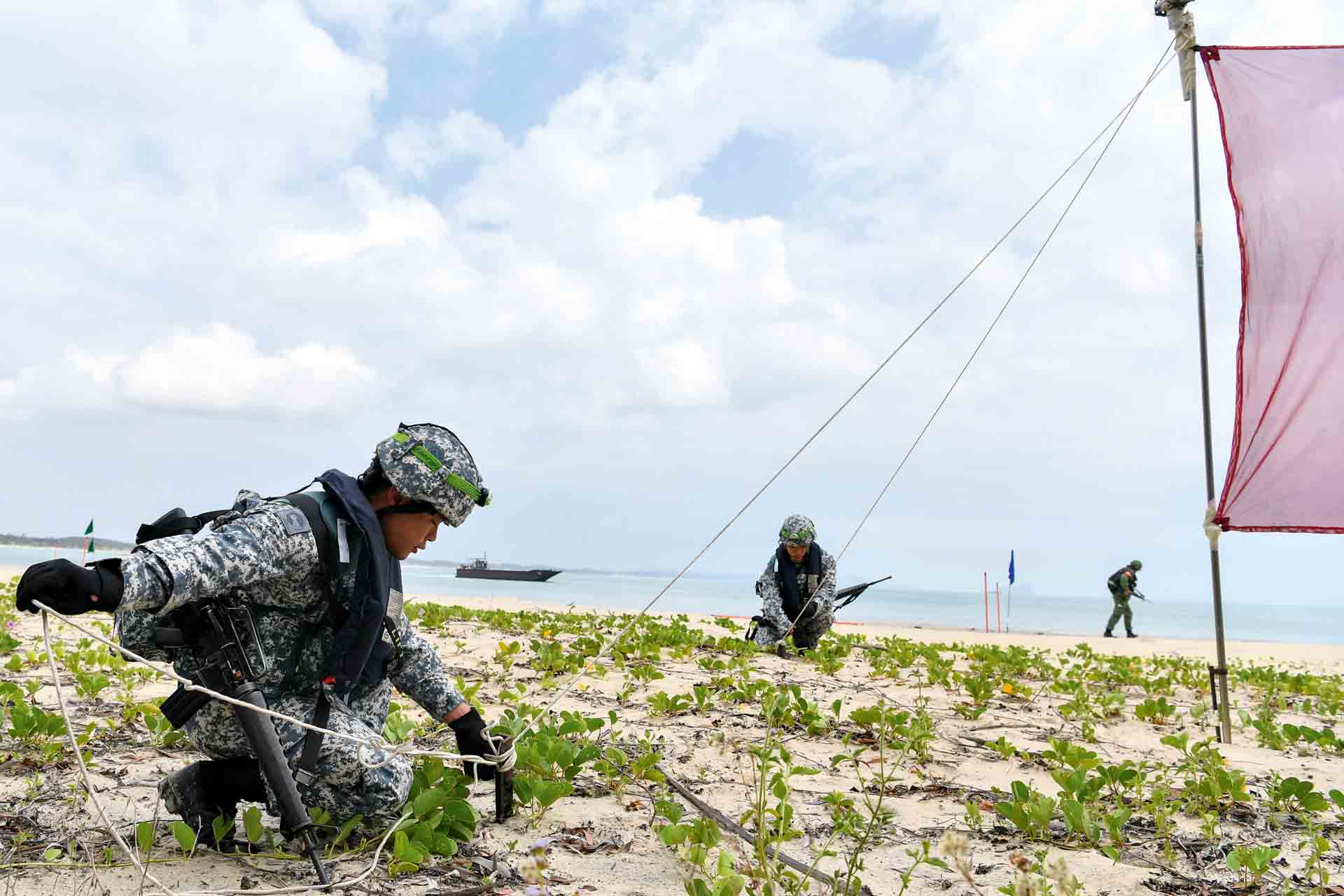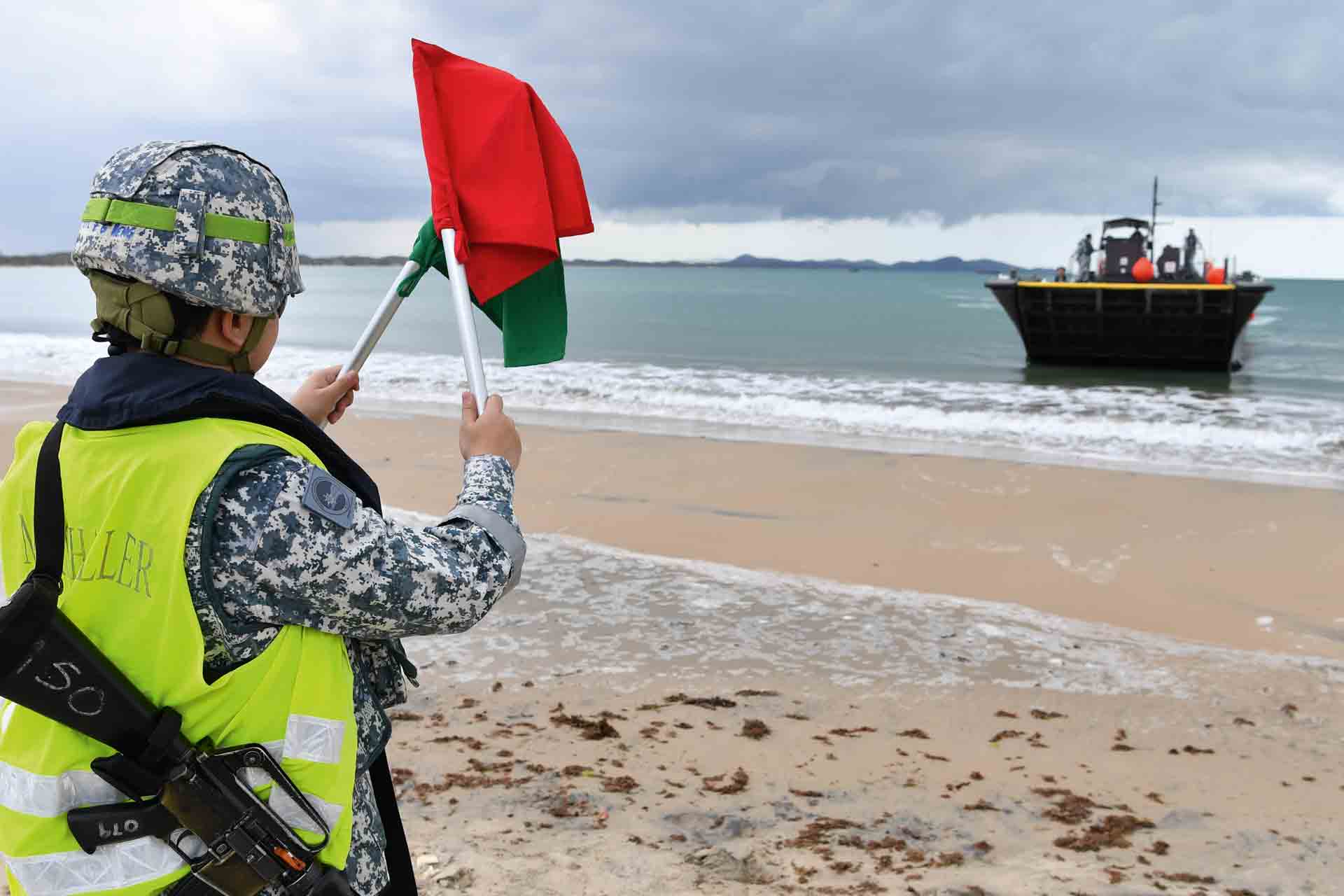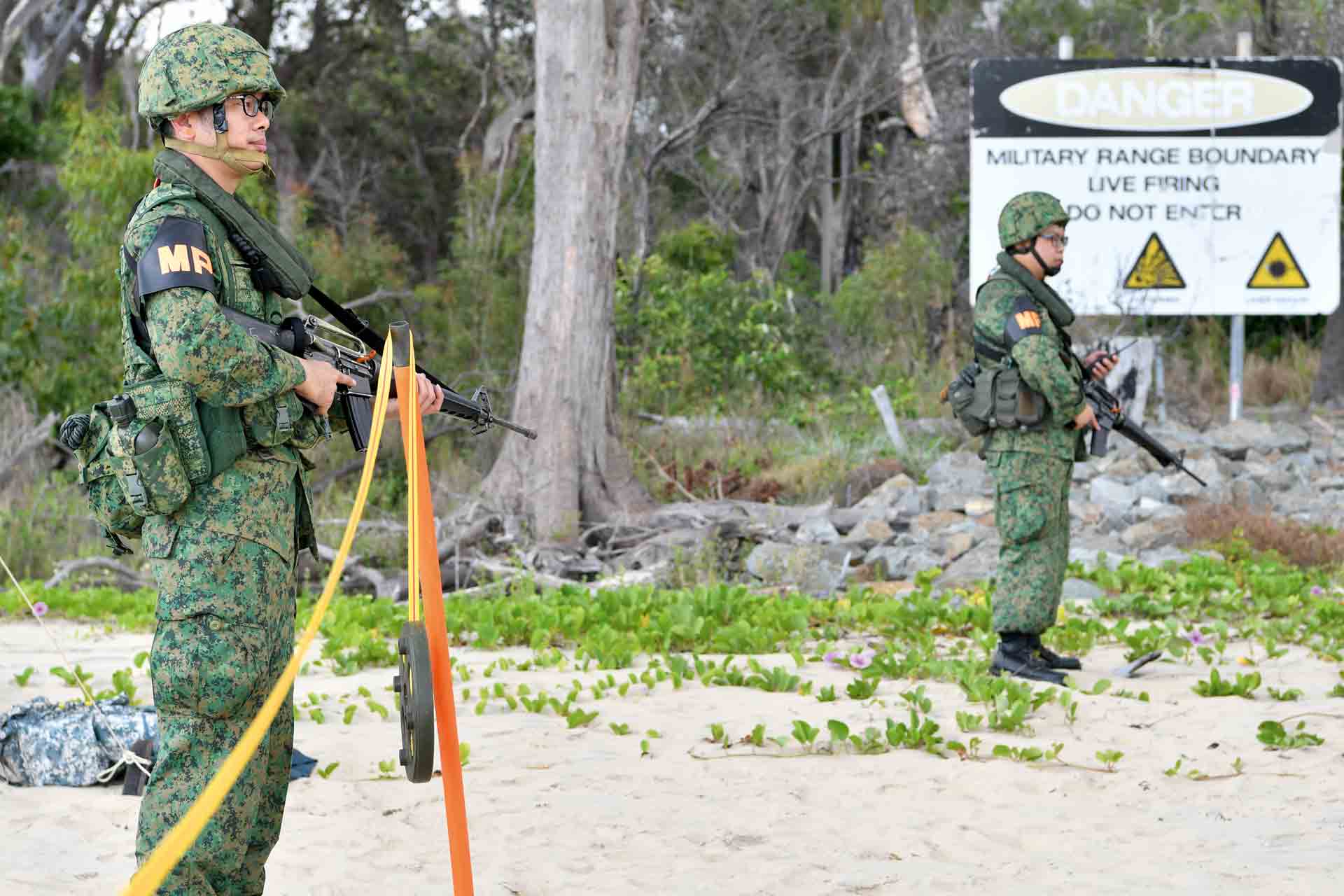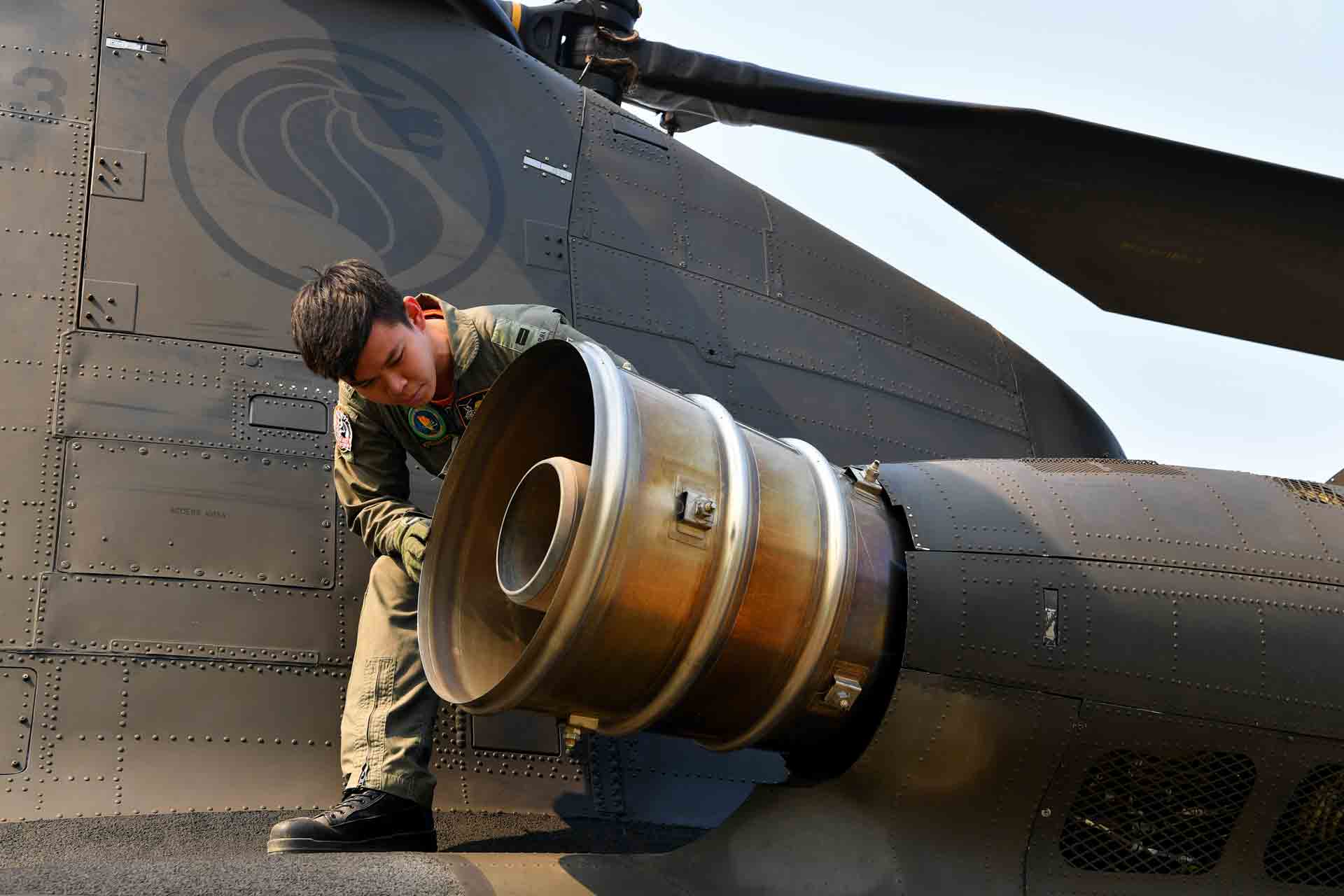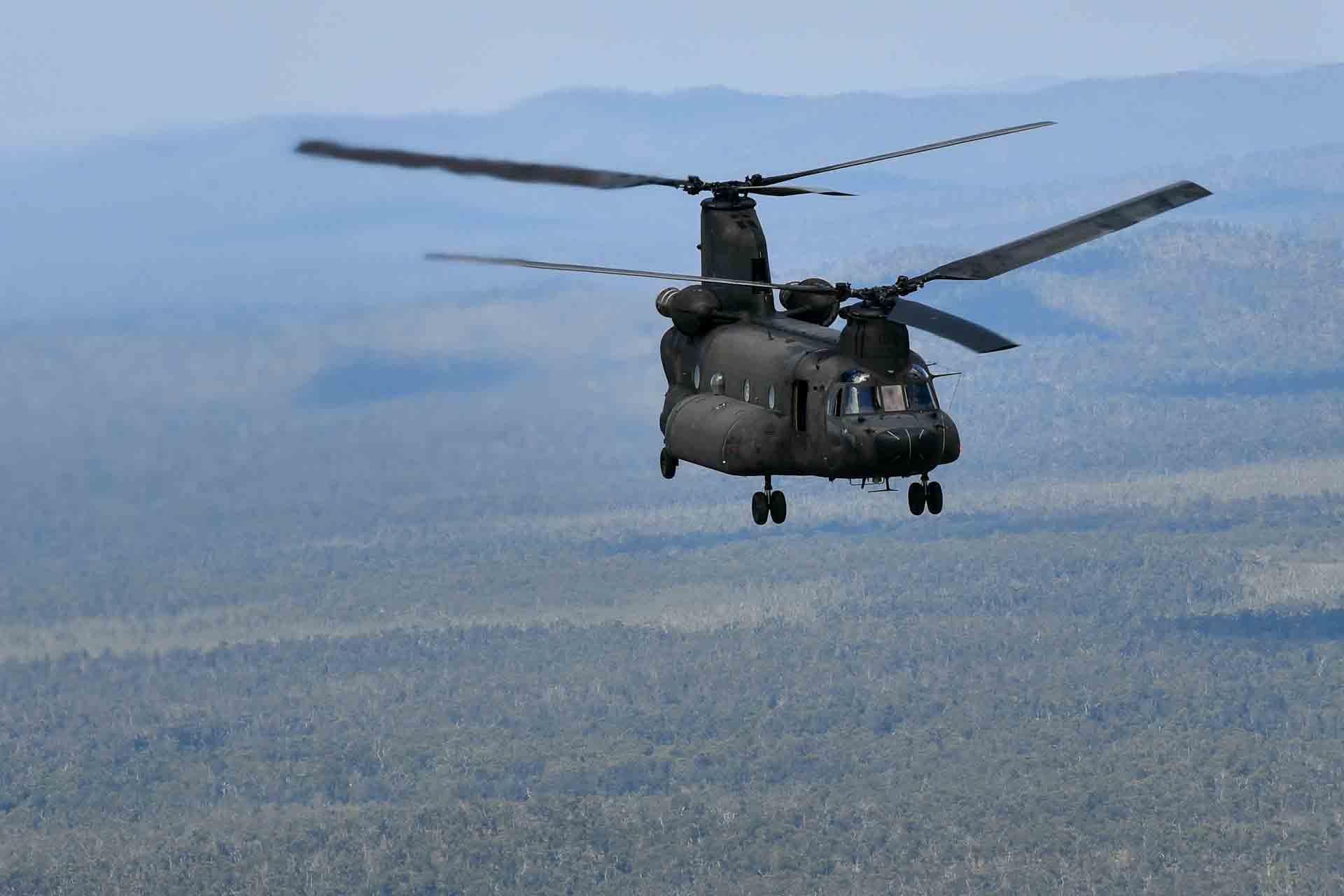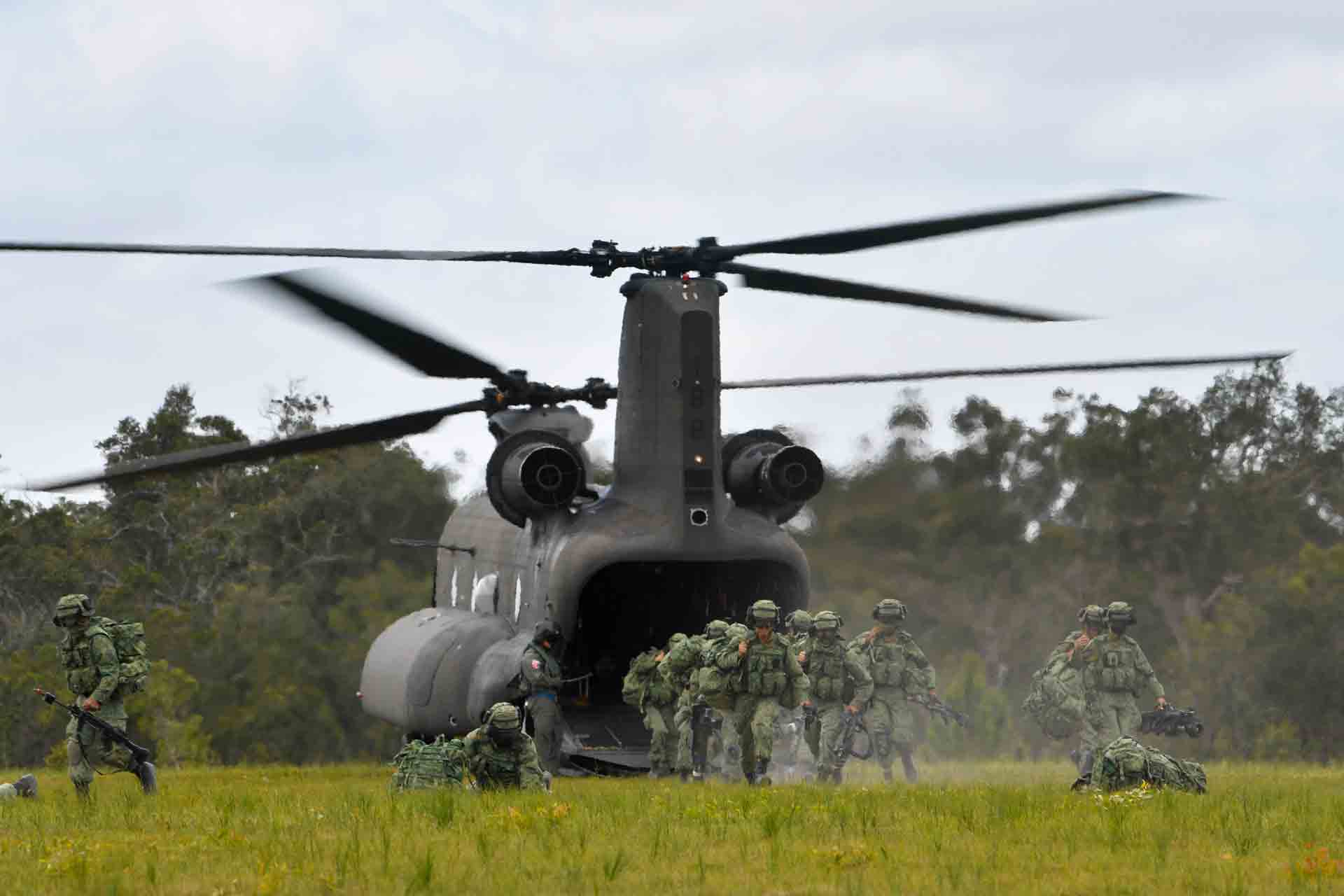OPS & TRAINING
TRAINING ON ALL FRONTS
03 Dec 2018
At this year’s Exercise Trident, the Army, Navy and Air Force take on challenging conditions to fight as one integrated force.
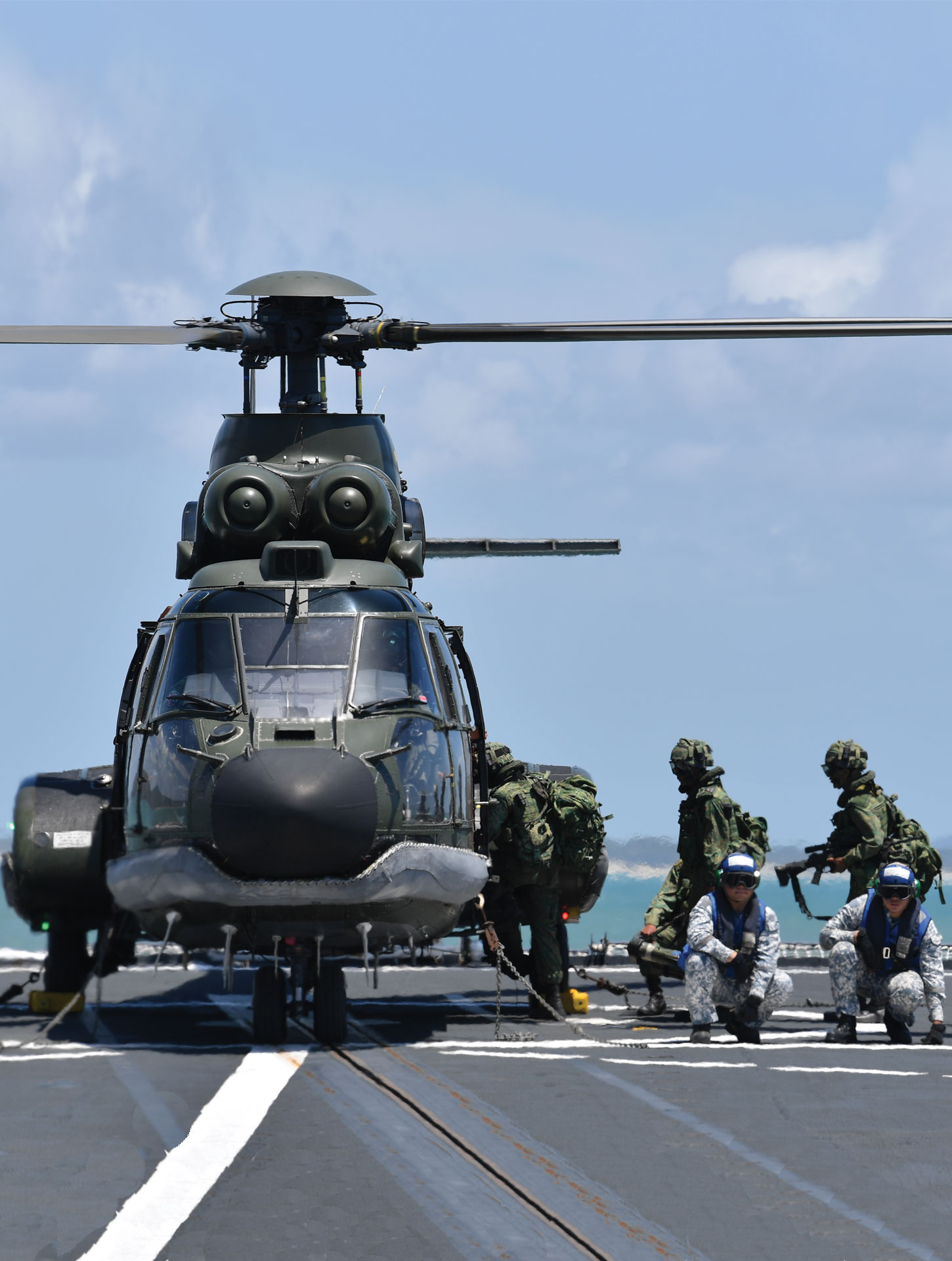
Poised and ready, Landing Ship Tank (LST) RSS Resolution is not a typical sight in the waters of Freshwater Bay at Shoalwater Bay Training Area (SWBTA) in Queensland, Australia.
There is nothing usual about her role here either — she is the launchpad for a complex bilateral mission involving the Singapore Armed Forces' (SAF's) air, land and sea assets.
In her keep are soldiers from the Singapore Army and Australian Defence Force (ADF), who were brought in by the Republic of Singapore Air Force's (RSAF's) CH-47D Chinook and AS332 Super Puma helicopters.
When the time comes, the SAF and ADF troops will load up onto fast craft to launch a beachhead attack, then carry on inland for an urban assault.
This is the scenario played out at Exercise Trident, a signature bilateral exercise between the SAF and ADF.
The exercise, which took place from 31 Oct to 14 Nov, featured more than 1,300 personnel from both armed forces. It also saw the largest participation from the ADF, with over 100 Australian troops involved.
Exercise Trident is the final frame of the annual Exercise Wallaby, which is the SAF's largest overseas exercise.
Director for Exercise Wallaby and Chief Guards Officer, Colonel Seet Uei Lim, noted that this remains the SAF's key exercise for tri-Service integrated training in a realistic and challenging environment.
"SWBTA's large training space allows the SAF to conduct exercises of a scale, scope and complexity which cannot be done in Singapore given our constraints."
Here's what went into pulling off the battalion-level amphibious operation.
Land
A week before D-Day, soldiers from both armed forces had already begun training together to work as one.
They exchanged techniques, tactics and procedures (or TTPs); shared details about weapons and personal gear; and conducted joint urban operations and helicopter drills.
Doing this allows the two armed forces to enhance their interoperability during the mission, explained Captain (CPT) Brian Chua, who commands the 1st Guards Battalion's Bravo Company.
"In the lead-up to our exercise, we've had joint planning and rehearsals… The Australians were very forthcoming, professional and willing to share their TTPs and experiences," he said.
To strengthen camaraderie, a platoon from the ADF was integrated into CPT Chua's company and vice versa.
His counterpart, Officer Commanding of 8th/9th Battalion, Royal Australian Regiment's Alpha Company, Major (MAJ) Pat D'arcy, echoed CPT Chua's sentiments. "The Singapore troops are extremely capable. We've done rehearsals with them and their standard operating procedures are very similar (to ours), so it's been easy to integrate."
Training opportunities for helicopter and ship-to-shore operations are hard to come by, so taking part in this exercise has given troops greater confidence in conducting such operations, added CPT Chua.
"With the landing beach at SWBTA, we have the opportunity to really integrate and exercise with the air and sea partners."
Exercise Wallaby 2018 in numbers
- Involves about 4,000 SAF personnel and close to 400 SAF assets
- Conducted over a span of almost two months from 19 Sep to 17 Nov, and comprised three main frames
- Marks 28 years of training this year. Began in 1990 and is the SAF’s largest overseas exercise
Reinforcing safety protocols
- The Forward Support Group"s medical team underwent daily emergency drills and rehearsals. An AS332 Super Puma helicopter was stationed in Camp Growl for evacuation purposes.
- As part of heat injury prevention measures, the Simplified Evacuation Protocol was implemented using the AVPU (Alert, Voice, Pain, Unresponsive) scale. Non-medically trained commanders and medics can give the call to evacuate an "unresponsive" casualty if he is unable to answer any one of three questions on identity, location and time.
- All Armour vehicle operators and commanders went through a mandatory Overseas Advanced Driving Training orientation package, which includes day and night driving across creeks, bridges and off-road terrain.
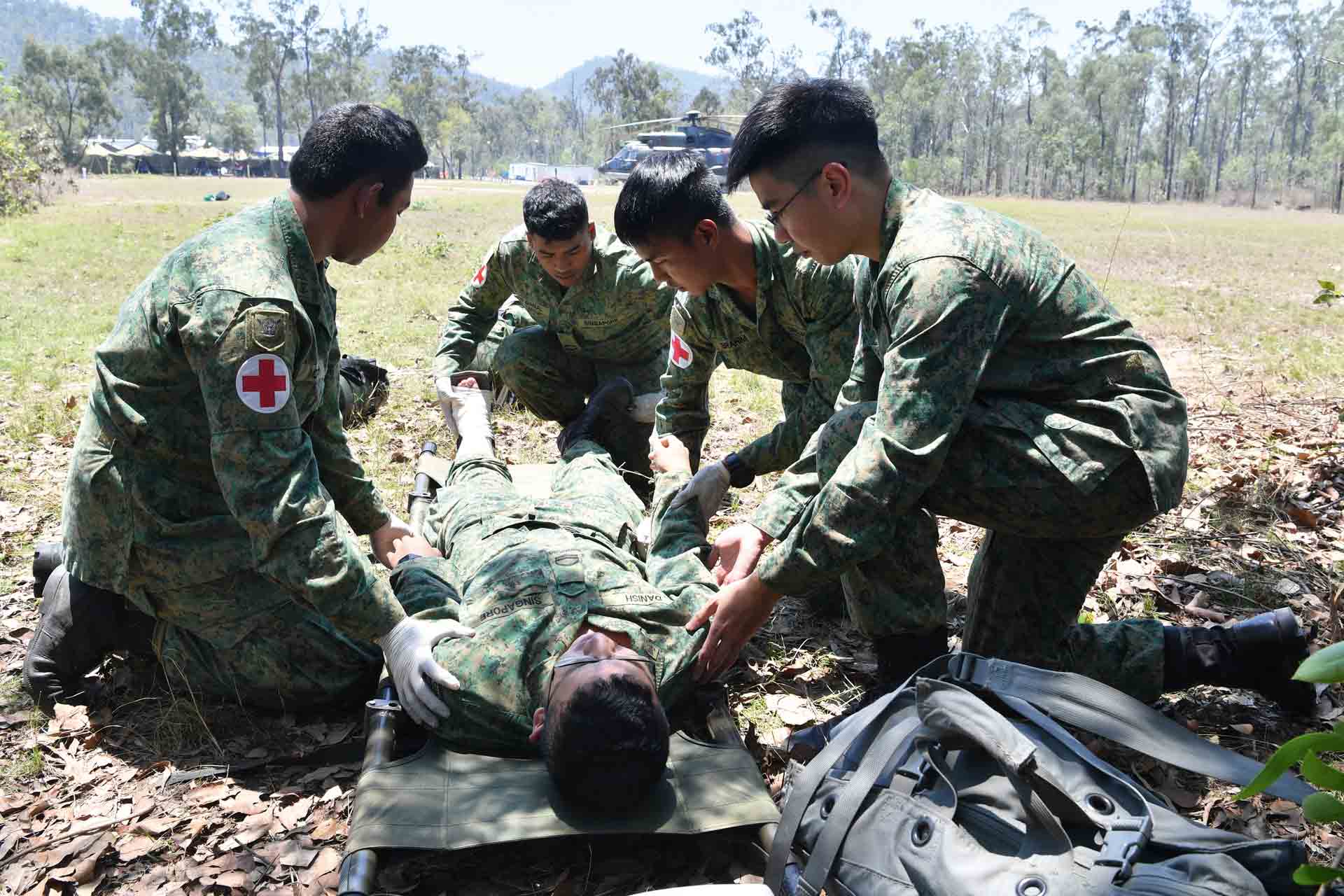
Sea
Out in the waters of Freshwater Bay, sailors on board RSS Resolution had to contend with harsh weather.
Fierce winds meant that helicopters could not land on deck to bring troops in, and choppy waters prevented the launch of fast craft from ship to shore.
"This is the environment we are working with here, which is good training for the Navy as a whole," said the Navy's Commander Task Group, Lieutenant Colonel (LTC) Kenny Chen.
"Every day, we have to adjust our plans but we (make sure to have) good communication among the three Services (so that) we are able to execute (our mission) and make it happen," he added.
For craft coxswain Corporal First Class (CFC) Kirk D'Souza, dealing with unpredictable weather comes on top of the task of docking his craft into designated lanes when transporting troops to the landing beach.
"It takes time and skill — you have to gauge (your way), through practice and training, in relation to other craft as well as to the beach," said the Full-Time National Serviceman, who is on his first overseas exercise.
LTC Chen, who was part of the team that conceptualised Exercise Trident in 2013, added that the exercise has changed in scope and scale to build up interoperability between Services.
"Back then, we conducted a humanitarian assistance and disaster relief scenario… We're getting better at understanding one another and we've changed it to a conventional scenario with a higher level of complexity."
Beach and Shore Party
The first to hit the beach, this group of Army and Navy personnel sets the stage for the main troops' amphibious operations.
S'pore, Australia will continue to expand collaboration: SMS Heng
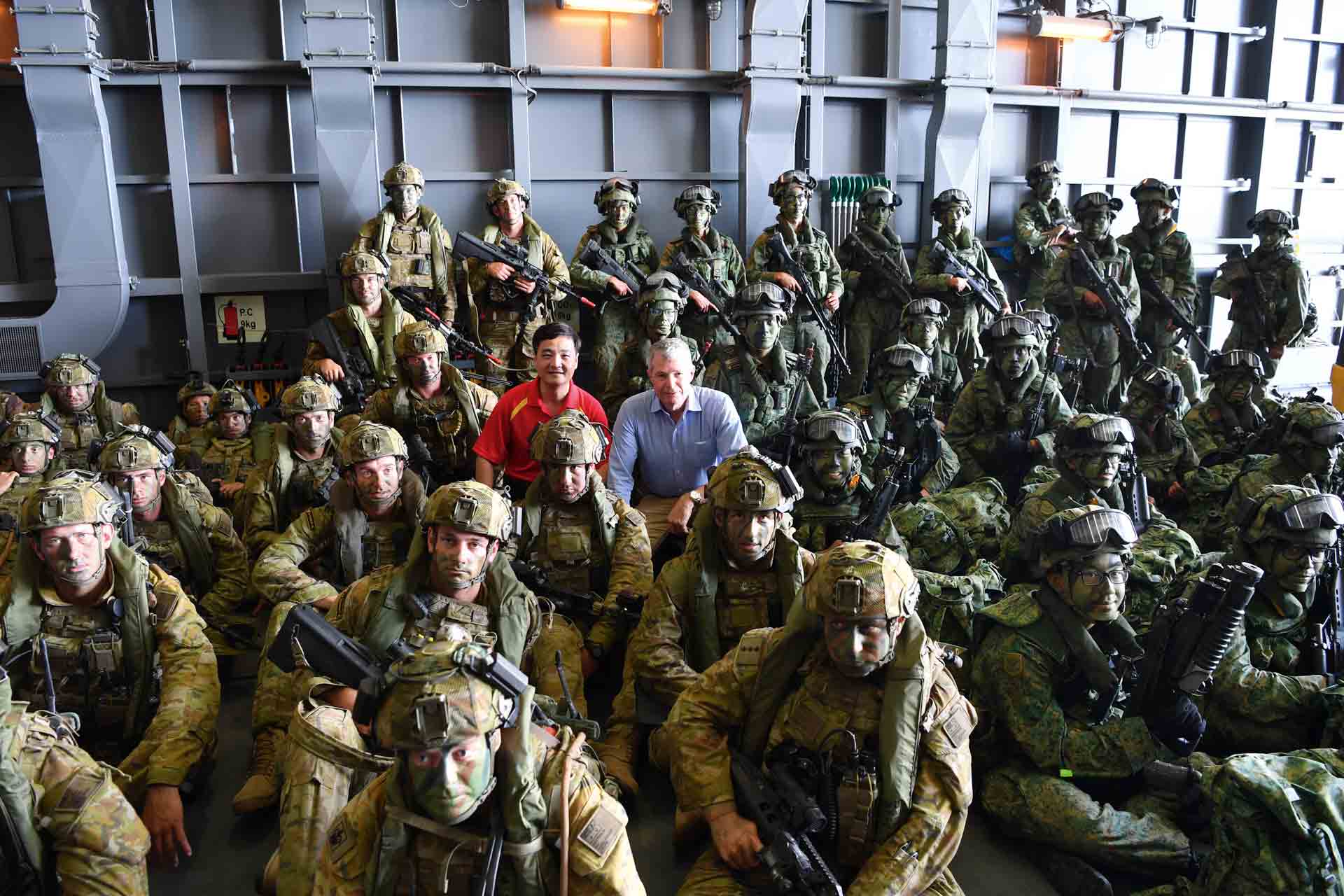
Senior Minister of State for Defence Heng Chee How (in red shirt) and Australia Assistant Minister for Defence David Fawcett (in blue) visited the SAF and ADF troops at Exercise Trident on 10 Nov, amid challenging sea conditions that put on hold the launch of fast craft for that day's ship-to-shore mission.
But the fact that the amphibious manoeuvre could not take place was "not a showstopper", said Mr Heng. "(We have) an all-weather partnership that has gone on for years… and we will continue to be here to expand our collaborations."
Mr Heng added that Exercise Trident would go on, saying: "It really gives us confidence that our troops are able to operate together."
Echoing Mr Heng's sentiments on the close relationship between the two nations, Mr Fawcett added: "The Comprehensive Strategic Partnership that we have and are developing is a good bedrock for bilateral training."
Air
In the vast terrain of SWBTA — four times the size of Singapore — it can take an entire day for ground troops to get where they need to be.
Enter the RSAF’s helicopters, which quickly airlift troops to their destination — be it on land or on an LST in the middle of the sea.
To ensure that air, land and sea assets can operate in the same arena, the controllers of the Air Land Tactical Control Centre, or ALTaCC, provide a big picture of troops on the ground and in the sea for pilots to plan their mission.
Said ALTaCC controller CPT Eileen Yeo: "We coordinate air assets with land and sea movements to maintain a safe airspace for the pilots."
For instance, if there was live firing on the ground, ALTaCC controllers would remind pilots to avoid that area. They are also responsible for coordinating helicopter movements with the Navy, once they transit towards the sea.
Such tri-Service scenarios are made possible because of the vast training area in SWBTA. But the terrain also presents different challenges, such as poor visibility caused by dust clouds when landing, said Super Puma air crew specialist Master Sergeant (MSG) (NS) Han Jun Kwang.
"The terrain here is very dry so when we land, there is a chance of a ‘brown-out’. This is something that would not happen in Singapore where the ground is more muddy," explained MSG (NS) Han, who acts as the pilot’s eyes and ears in the cabin.
An Operationally Ready National Serviceman participating in Exercise Trident for the third time, MSG (NS) Han said: "I volunteered because the flying environment and scenarios here are different compared to Singapore, and I enjoyed my In-Camp Training here."
The real value of Exercise Trident lies in how the three Services can train together, said Air Director Senior Lieutenant Colonel Maxmillion Goh.
"Exercise Trident gives us unique opportunities to conduct integrated training with our Army and Navy counterparts, to develop close understanding…and trust in each other’s capabilities.
"So when we do conduct operations together, we are able to fight as one integrated force."
RSAF detachments in Oakey & Pearce celebrate milestones down under
As part of his visit to Australia, Senior Minister of State for Defence Heng Chee How joined in the Republic of Singapore Air Force's (RSAF's) celebrations for 20 years of helicopter training in Oakey (held on 10 Nov) and 25 years of training in Pearce (held on 12 Nov). Here's the lowdown on the two detachments:
Oakey
Where is it? Oakey, Queensland, with a training airspace 17 times the size of Singapore
Who's there? Oakey Detachment, which operates the CH-47D Chinook helicopters, and Oakey Training Centre, which operates the AS332 Super Puma helicopters
Since when? The Oakey Training Centre was first established at the Oakey Army Aviation Centre in September 1998. This August, the detachment expanded to include the Chinooks.
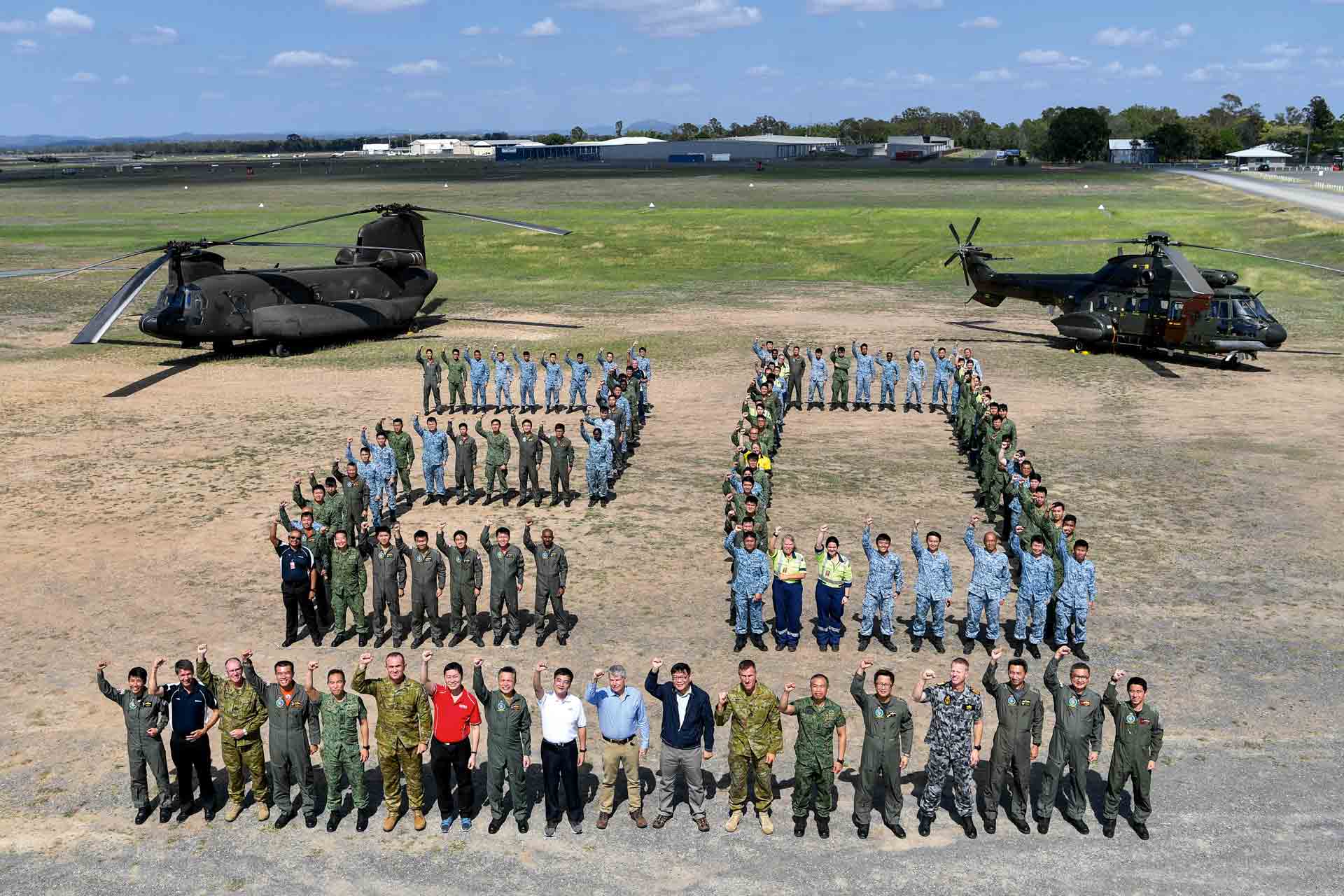
Pearce
Where is it? Pearce, Western Australia, with a training airspace 14 times the size of Singapore
Who's there? 130 Squadron, which trains pilot and weapon systems officer trainees on the Pilatus PC-21 trainer aircraft, and Standard Squadron, which trains flying instructors
Since when? In March 1993, a memorandum of understanding was signed to establish the flying training detachment. The Pearce Treaty was signed last year to extend training at Royal Australian Air Force Base Pearce for another 25 years.
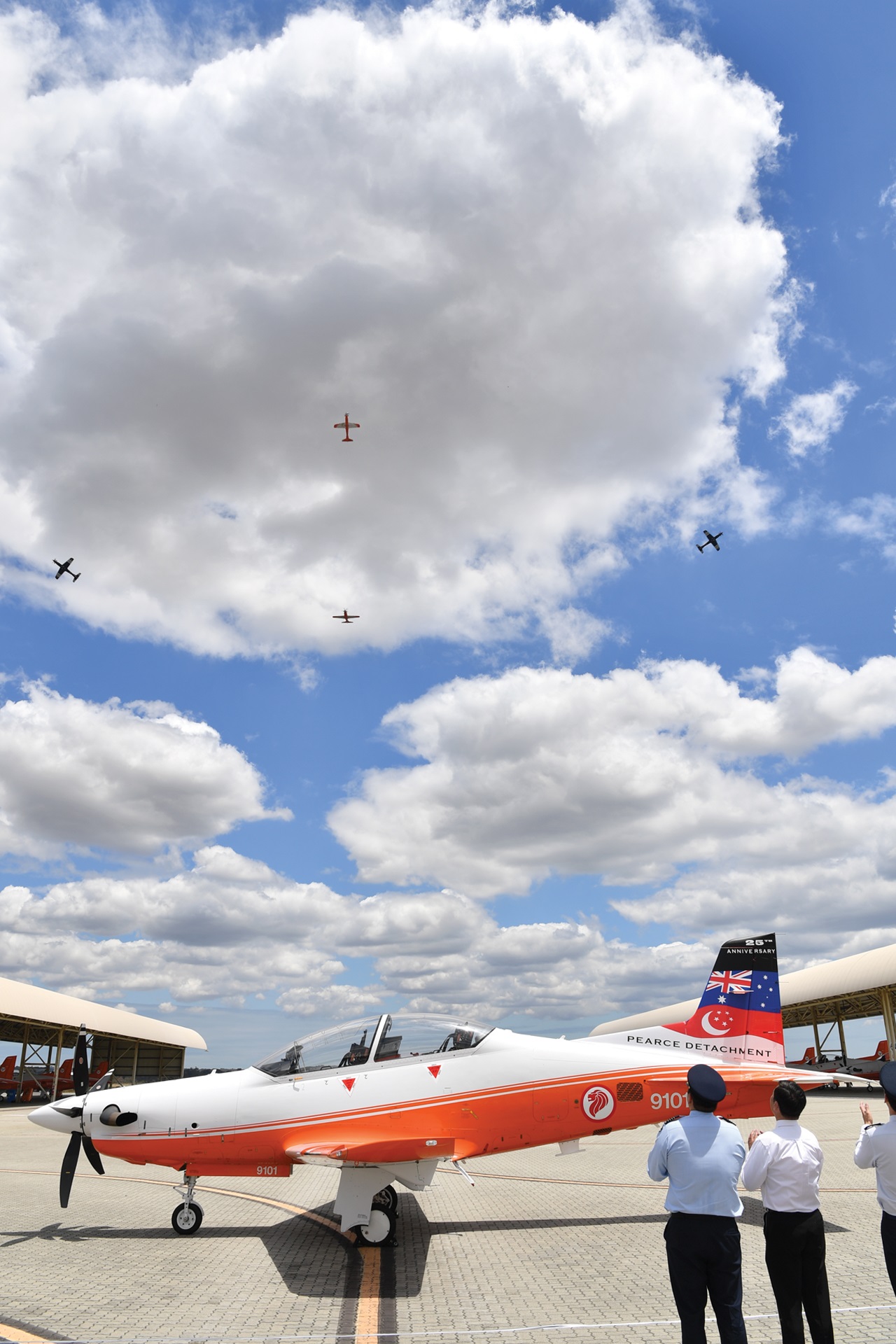
ALSO READ IN OPS & TRAINING
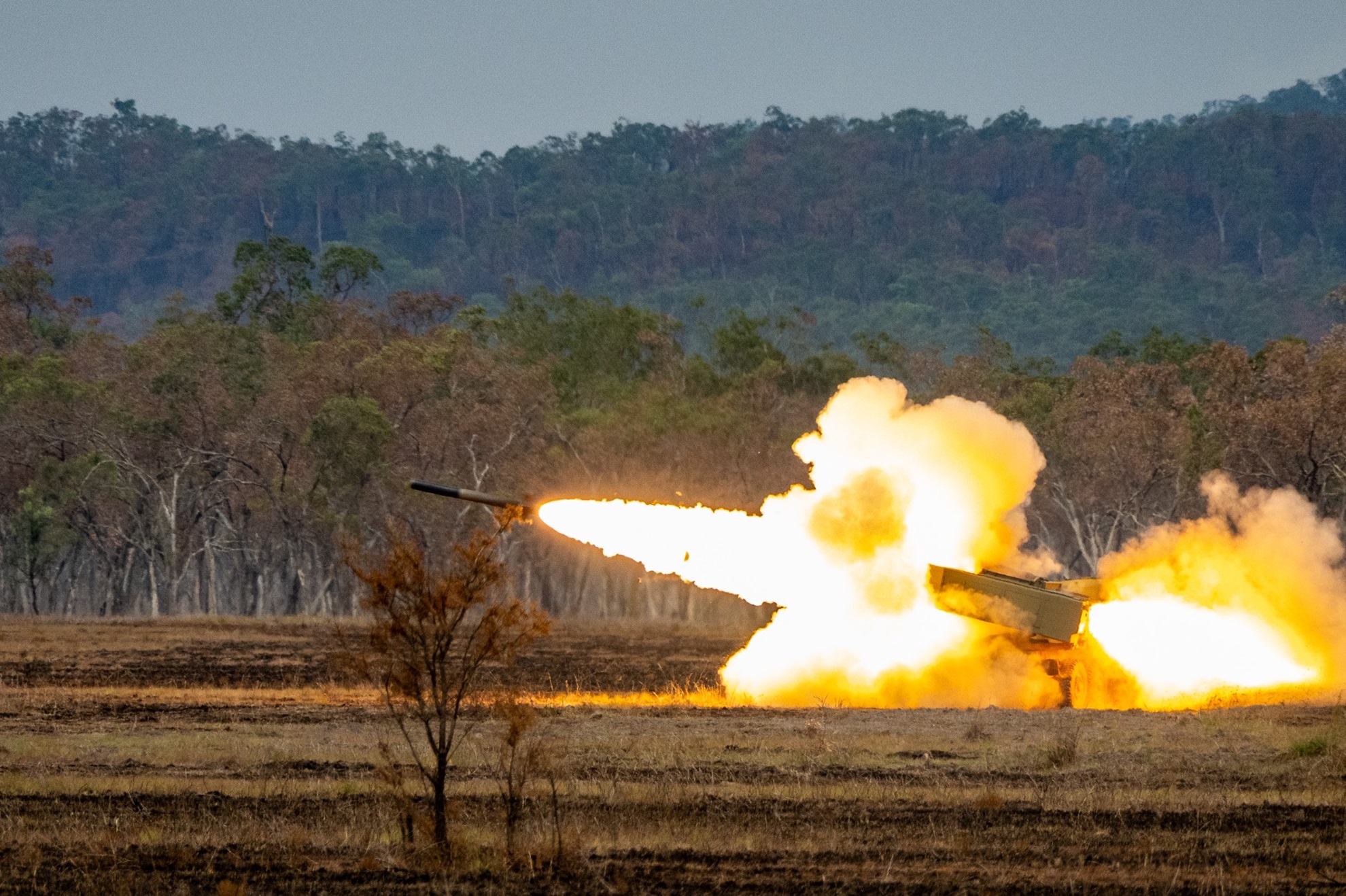
Exercise Wallaby 2025: To see better, shoot faster
31 Oct 2025
The SAF focuses on complex strike missions and multi-domain integration in Exercise Wallaby 2025, the 35th edition of its largest unilateral overseas exercise.
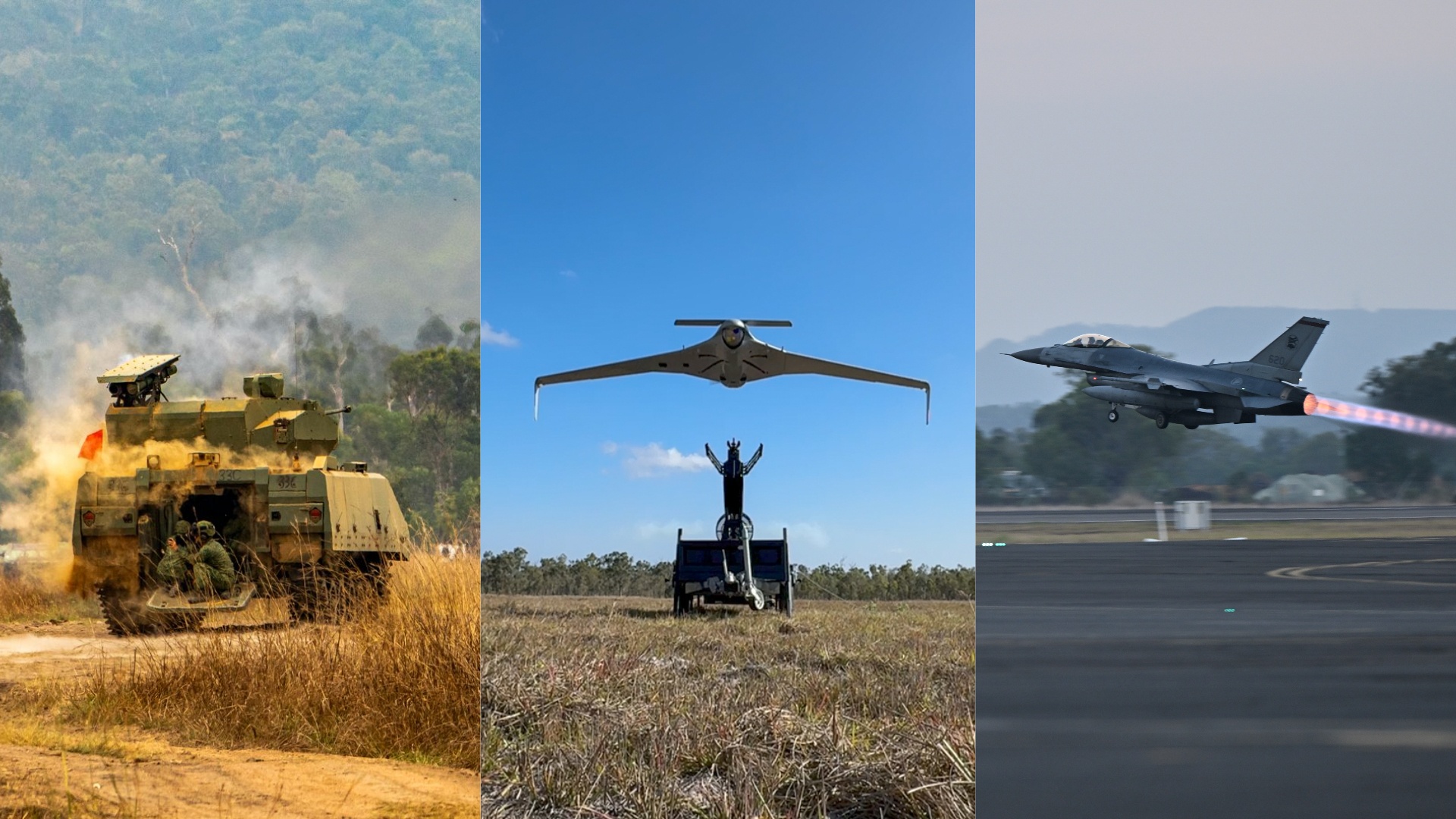
Ex Wallaby 25 – Greater Integration and Complexity
25 Oct 2025
The 35th edition of the SAF’s largest unilateral overseas exercise is an opportunity for expanded scale and deeper integration towards an effective, networked fighting force.

Ex Forging Sabre ramps up use of unmanned assets in integrated strike operations
12 Sep 2025
In this 10th edition of Exercise Forging Sabre, the SAF sharpened its cutting edge for the dynamic modern battlefield, with expanded integration between manned and unmanned platforms.



